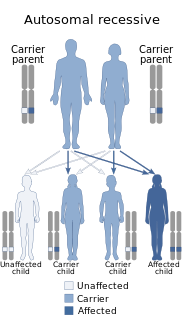
Acanthosis nigricans is a medical sign characterised by brown-to-black, poorly defined, velvety hyperpigmentation of the skin. It is usually found in body folds, such as the posterior and lateral folds of the neck, the armpits, groin, navel, forehead and other areas.

Ectodermal dysplasia (ED) is a group of genetic syndromes all deriving from abnormalities of the ectodermal structures. More than 150 different syndromes have been identified.

Popliteal pterygium syndrome (PPS) is an inherited condition affecting the face, limbs, and genitalia. The syndrome goes by a number of names including the popliteal web syndrome and, more inclusively, the facio-genito-popliteal syndrome. The term PPS was coined by Gorlin et al. in 1968 on the basis of the most unusual anomaly, the popliteal pterygium.
Crouzonodermoskeletal syndrome is a disorder characterized by the premature joining of certain bones of the skull (craniosynostosis) during development and a skin condition called acanthosis nigricans.
Amastia refers to a rare clinical anomaly in which both internal breast tissue and the visible nipple are absent on one or both sides. It affects both men and women. Amastia can be either isolated or comorbid with other syndromes, such as ectodermal dysplasia, syndactaly and lipoatrophic diabetes. This abnormality can be classified into various types, and each could result from different pathologies. Amastia differs from amazia and athelia. Amazia is the absence of one or both mammary glands but the nipples remain present, and athelia is the absence of one or both nipples, but the mammary gland remains.

Hypohidrotic ectodermal dysplasia is one of about 150 types of ectodermal dysplasia in humans. Before birth, these disorders result in the abnormal development of structures including the skin, hair, nails, teeth, and sweat glands.

Hay–Wells syndrome is one of at least 150 known types of ectodermal dysplasia. These disorders affect tissues that arise from the ectodermal germ layer, such as skin, hair, and nails.
Rabson–Mendenhall syndrome is a rare autosomal recessive disorder characterized by severe insulin resistance. The disorder is caused by mutations in the insulin receptor gene. Symptoms include growth abnormalities of the head, face and nails, along with the development of acanthosis nigricans. Treatment involves controlling blood glucose levels by using insulin and incorporating a strategically planned, controlled diet. Also, direct actions against other symptoms may be taken This syndrome usually affects children and has a prognosis of 1–2 years.

Rosselli–Gulienetti syndrome, also known as Zlotogora–Ogur syndrome and Bowen–Armstrong syndrome, is a type of congenital ectodermal dysplasia syndrome. The syndrome is relatively rare and has only been described in a few cases.
Oculodentodigital syndrome is an extremely rare genetic condition that typically results in small eyes, underdeveloped teeth, and syndactyly and malformation of the fourth and fifth fingers. It is considered a kind of ectodermal dysplasia.

EEM syndrome is an autosomal recessive congenital malformation disorder affecting tissues associated with the ectoderm, and also the hands, feet and eyes.
Schöpf–Schulz–Passarge syndrome is an autosomal recessive condition with punctate symmetric palmoplantar keratoderma, with the keratoderma and fragility of the nails beginning around age 12. In addition to palmoplantar keratoderma, other symptoms include hypodontia, hypotrichosis, nail dystrophies, and eyelid cysts. Patients may also develop syringofibroadenoma and squamous cell carcinomas.
Rapp–Hodgkin syndrome was formerly thought to be a unique autosomal dominant disorder due to a P63 gene mutation. However, it was recently shown to the same disease as Hay–Wells syndrome.
Ectodermal dysplasia with corkscrew hairs is a skin condition with salient features including exaggerated pili torti, scalp keloids, follicular plugging, keratosis pilaris, xerosis, eczema, palmoplantar keratoderma, syndactyly, onychodysplasia and conjunctival neovascularization.

Rudiger syndrome is a congenital disorder characterized by the association of severe growth retardation with abnormalities of the extremities, urogenital abnormalities and facial abnormalities. It has been described in a family where an affected brother and sister died as infants. Both autosomal recessive and autosomal dominant inheritance have been suggested with the disorder.
Focal facial dermal dysplasia is a rare genetically heterogeneous group of disorders that are characterized by congenital bilateral scar like facial lesions, with or without associated facial anomalies. It is characterized by hairless lesions with fingerprint like puckering of the skin, especially at the temples, due to alternating bands of dermal and epidermal atrophy.

Severe achondroplasia with developmental delay and acanthosis nigricans (SADDAN) is a very rare genetic disorder. This disorder is one that affects bone growth and is characterized by skeletal, brain, and skin abnormalities. Those affected by the disorder are severely short in height and commonly possess shorter arms and legs. In addition, the bones of the legs are often bowed and the affected have smaller chests with shorter rib bones, along with curved collarbones. Other symptoms of the disorder include broad fingers and extra folds of skin on the arms and legs. Developmentally, many individuals who suffer from the disorder show a higher level in delays and disability. Seizures are also common due to structural abnormalities of the brain. Those affected may also suffer with apnea, the slowing or loss of breath for short periods of time.

Acanthosis nigricans-muscle cramps-acral enlargement syndrome, also known as Acanthosis nigricans-insulin resistance-muscle cramps-acral enlargement syndrome is an extremely rare genetic disorder which is characterized by the appearance of acanthosis nigricans, insulin resistance, muscle cramps of severe intensity, and acral hypertrophy/enlargement. Only 2 cases have been reported in medical literature.






